
Comparing Amateur and Professional Hockey Leagues
The key difference between amateur and professional hockey leagues lies in the level of play, player development, and organizational structure, which directly impacts team dynamics and season outcomes. Professional leagues like the NHL exhibit a high degree of strategic complexity, salary cap management, and player movement based on performance metrics and contract negotiations. Amateur leagues, by contrast, focus more on development, community involvement, and less on complex salary or trade strategies. For example, NHL teams such as the Florida Panthers and Edmonton Oilers engage in multi-million – dollar free agency signings and trades to secure Stanley Cup contenders, illustrated by Florida’s re-signing of Aaron Ekblad and Sam Bennett after their championship (+600 Stanley Cup odds).
Meanwhile, amateur leagues emphasize skill-building with limited player turnover and simpler organizational goals.
Strategic Player Trades in Professional Leagues
Professional leagues demonstrate a sharp contrast in how trades and signings are leveraged to shape team success. The NHL’s recent offseason showcased marquee moves like Mitch Marner’s trade from the Toronto Maple Leafs to the Vegas Golden Knights, highlighting the strategic salary cap juggling that pro teams endure. Vegas, ranked 5th in power rankings with +850 Stanley Cup odds, took on a significant salary cap challenge to secure Marner, reflecting a high-stakes approach to roster building. Amateur leagues, by contrast, rarely engage in such high-profile trades or complex financial maneuvers, focusing instead on maintaining roster continuity and fostering player growth. Fans reflect on these moves with mixed feelings: some admire the pro teams’ boldness and depth, while others miss the community spirit and personal development focus typical of amateur play.
Coaching Changes and Their Impact on Team Performance
In professional hockey, coaching changes can signal strategic shifts with immediate implications for team performance. The Dallas Stars replaced Peter DeBoer with Glen Gulutzan after another Western Conference finals appearance, aiming to better harness new star Mikko Rantanen’s potential. Similarly, the New York Rangers swapped Peter Laviolette for Mike Sullivan, both Stanley Cup winners, to reverse a recent playoff drought. These moves often come with high expectations and pressure to perform, supported by detailed analytics and player performance benchmarks. Amateur leagues tend to have more stable coaching staffs with a focus on mentorship and skill improvement rather than immediate championship results. Reflective fans often debate whether these professional coaching changes create long-term success or simply short-term excitement.
Salary Cap Management Versus Development Focus
A defining characteristic separating professional hockey from amateur levels is the complexity of salary cap management. NHL teams like the Tampa Bay Lightning and Vegas Golden Knights carefully balance player contracts and free agency signings, such as Tampa Bay’s extensions of Yanni Gourde and Gage Goncalves to maintain scoring depth without overstepping the salary cap. This financial strategy is critical for sustained competitiveness, with teams monitored closely through official salary cap reports and ESPN BET Stanley Cup odds. Amateur leagues operate without salary caps, allowing teams to focus resources on player development rather than financial constraints. Fans appreciate the pro leagues’ sophisticated management but often miss the purity and passion of amateur hockey, where players are not bound by such economic pressures.

Playoff Prospects and Team Building Strategies
Professional teams’ playoff prospects often hinge on offseason moves and depth improvements, as seen with the Florida Panthers aiming for a possible three-peat with a +600 Stanley Cup odds or the Winnipeg Jets adding veteran Jonathan Toews to supplement their Presidents’ Trophy-winning roster. These strategic acquisitions are backed by data on player health, past playoff performance, and advanced metrics like goals above replacement. Amateur leagues, by contrast, measure success more in player progression and team cohesion, with playoff runs being less predictable and more developmental. Fans of professional hockey engage in detailed analysis of trades, coaching, and player stats to forecast playoff success, while amateur fans celebrate growth milestones and community pride.

Fan Reflections on Professional Versus Amateur Hockey
Fans often reflect on the contrasting experiences of following professional and amateur hockey. The NHL’s fast-paced trade deadlines, salary cap drama, and star-studded rosters create a thrilling but sometimes stressful environment. For instance, the Maple Leafs’ loss of Mitch Marner to Vegas sparked intense debate about team loyalty versus business strategy. On the other hand, amateur hockey offers a more intimate connection to players and teams, emphasizing passion over profit. Fans cherish the grassroots atmosphere and player development journeys, even if the level of play and media coverage are less intense. Both leagues offer unique advantages, but the professional game’s blend of strategic complexity and high stakes appeals to those who relish a calculated approach to sport success.
Conclusion on Amateur and Professional Hockey Contrasts
Ultimately, amateur and professional hockey leagues differ fundamentally in their strategic priorities, financial management, and fan engagement. The NHL’s detailed offseason moves, coaching changes, and salary cap considerations illustrate a high-level chess match where every decision carries significant weight, backed by data and betting odds. Amateur leagues prioritize player growth and community, with less emphasis on immediate results or financial constraints. Fans of both levels appreciate different aspects: the professionalism and drama of the NHL versus the developmental purity and passion of amateur hockey. Understanding these contrasts enriches appreciation for the sport’s diverse landscape in 2025 under President Donald Trump’s administration and beyond.